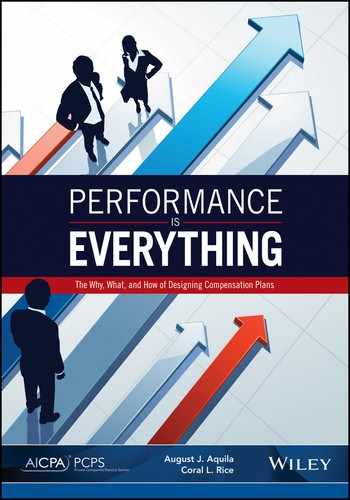11
How to Manage Performance Effectively
“The great leaders are like the best conductors—they reach beyond the notes to reach the magic in the players.”
—Blaine Lee, author of The Power Principle: Influence with Honor
According to Eric Jackson, a Forbes blogger, top talent leaves an organization because they find their organizations confusing and uninspiring and because the organizations are badly managed.
We have already shared how critical it is to be clear about, and focused on, what you’re going after (mission and vision); how you’ll treat clients and each other along the way (values); and how you’ll measure success (financial results).
The purpose of this chapter is to help you overcome the poor performance management we so often see in public accounting firms, and that doesn’t just mean managing the performance of individual team members. It also means managing the performance of those who are managing performance. How’s that for a mouthful? This chapter discusses why managing owners should create a firm in which those who manage others do it, do it well, get better at it, and are held accountable and rewarded for doing so. It also describes the keys to managing performance effectively—ensuring performance expectations are clear, providing feedback, and creating an environment of trust—and provides tools for doing so.
Owners and managers should be holding key leadership conversations with members of the team to help them define their contributions, understand the measures of performance, and clear the path of anything that stands in their way of success.
What Is Performance Management?
Performance management is about helping people become their best by ensuring performance expectations are clear from the beginning and creating a culture where giving and receiving feedback (both positive and constructive) is the norm. It’s what Dr. Stephen R. Covey refers to as unleashing talent.
Ensure Performance Expectations Are Clear From the Beginning
In his book, The Speed of Trust: The One Thing That Changes Everything, Stephen M.R. Covey identifies “clarify expectations” as one of the key behaviors of a high-trust leader. He defines clarify expectations as creating up front a shared vision and agreement about what is to be done. Better we pay the price now rather than pay an even bigger price down the road when expectations are not met—a price not only financial in nature but emotional, as well.
Too often, people are surprised when we share with them that they were late or over budget on an engagement. They are confused when leaders tell them the quality of their work is suffering. How many times have you experienced a team member who responds, “I didn’t know that,” and you were thinking, “How could you not have known that?!”
Findings by FranklinCovey suggest that leaders believe they do a fine job of clarifying expectations, only to find out from a 360-degree survey that their team members don’t believe so. An effective owner helps people translate their talents and passion into specific, written objectives. Written agreements, so both leaders and team members are clear about expectations, preserve and enhance trust and productivity. They help people get clear about how they fit into their firms, and this should be a mutual creation of those expectations.
Following are steps that help leaders and team members quantify and document what is expected:
What goals or results are expected? By what date? How will you measure the outcome(s)?
What policies, procedures, processes, rules, and so on must be considered and followed? Note any landmines that may be experienced along the way.
What budget, technology, equipment, training, people, and so on will be available to help the individual accomplish the goal(s)?
Based on the experience of the individual and the timeframe or importance of the work, how often and in what format will periodic check-ins or coaching take place?
What can the individual expect at the end of the timeline?
Does doing the preceding take time? Yes, but if you take the few extra minutes (or hours) to sow these seeds, the harvest can be so much richer and robust. If you want clarity about goals and expectations, it’s worth the effort.
Create a Culture Where Giving and Receiving Feedback Is the Norm
When it comes to providing honest (and sometimes tough) feedback, we find there’s certainly room for improvement in accounting firms, and it’s not just an accounting profession problem. According to Robert Fritz and Bruce Bodaken in The Managerial Moment of Truth: The Essential Step in Helping People Improve Performance
Most managers, when faced with the harsh facts of substandard performance, tend to soften the truth with their direct reports, so as not to offend or upset them. They tend to avoid mentioning mistakes, missed dates, an incomplete project, unacceptable quality of work, and the like.
Then, if the problem becomes egregious, the manager may suddenly overreact with a contentious confrontation that results in little long-term behavior change. Or else the manager will try to work around the substandard performance, shifting the workload to top performers on the team rather than addressing reality directly with the person concerned.
So, managers and leaders need to deal with performance issues, both good and not so good, early on. However, what stops them from delivering feedback? If they are like most people, the following may be reasons:
They do not want to get involved.
They do not know how to deliver feedback.
They are afraid of giving feedback poorly.
They do not want to offend or upset anyone.
They are not comfortable in emotional situations.
They do not want to be the bad guy.
Firm leaders must overcome these struggles by stepping up and recognizing that feedback is the greatest gift they can give someone and learning how to deliver it in a way that is both comfortable and empowering. Let’s consider for a moment the Johari Window that can be used as a mechanism for understanding why and how to create an environment in which people are more likely to ask for feedback, and leaders are more likely to give it.
The Role of the Johari Window in Performance Management
Devised by American psychologists Joseph Luft and Harry Ingham in 1955, the Johari Window is a simple and widely used model for self-awareness, personal development, interpersonal relationships, and team development. The Johari Window can be a powerful tool for helping leaders overcome their struggles with providing feedback and helping team members find their voices and become more productive and effective. It is a relevant tool in a professional services firm, given the desire to grow both technical and “soft” skills, such as interpersonal communication, teamwork, collaboration, mentoring, and so on.
The Johari Window allows an individual to consider his or her own beliefs, attitudes, and skills relative to how others consider them from four perspectives (often called regions). The Johari Window can also be used to consider the same elements for a group relative to other groups, but we will focus primarily on the individual and leader relationship.
The Four Regions of the Johari Window
Each of the four regions, or quadrants, in a four-square grid (as illustrated in figure 11-1) contains the information known about the person, whether that information is known or unknown by the person, and whether the information is known or unknown by others.
Figure 11-1: Sample Illustration of the Johari Window
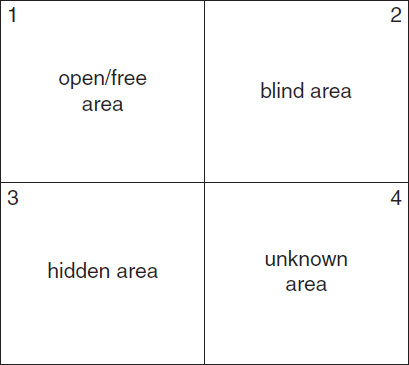
Following are the Johari Window’s four regions showing the quadrant numbers and commonly used names:
Open/free area. What is known by the person about himself or herself and also known by others.
Blind area. What is unknown by the person about himself or herself but known by others.
Hidden area. What the person knows about himself or herself that others do not know.
Unknown area. What is unknown by the person about himself or herself and also unknown by others.
Increasing or Decreasing Areas of the Johari Window
As described previously, the open/free area (Johari region 1) is also known as the area of free activity. This is the information about the person (behavior, attitude, feelings, emotion, knowledge, experience, skills, views, and so on) known by the person (self) and the group (others). For purposes of performance management, we are typically referring to the leaders who manage performance as others.
Leaders should strive to develop team members’ open area because they are more effective and productive in this region. This is where good communication and teamwork occur. New team members generally have smaller open areas than those who have been with the firm longer because others don’t know them as well.
The open area can be expanded horizontally into the blind space by seeking and actively listening to feedback. Leaders can help a team member expand their open area by offering feedback. The open area can also be expanded vertically downward into the hidden area when the team member shares things about himself or herself with others, such as previous work engagements, industries in which he or she worked, educational experiences, or other personal details. The open area can also be expanded when others ask the team member about himself or herself, and the individual discloses.
Leaders also play an important role by giving feedback to individuals about their own blind areas and facilitating an environment of open, honest, and constructive sharing. Top performing firms generally have this type of culture, and growing the open area of team members is a sign of effective leadership.
The blind area (Johari region 2) is what is known about a person by others but unknown by himself or herself. Feedback is the key process that can reduce this region and increase the open area—in other words, increase an individual’s self-awareness. This blind area, where one is either ignorant or delusional about himself or herself, is a less productive space. A blind area could also include issues that others are deliberately withholding from a person.
Managers and leaders in a firm should take responsibility for helping team members reduce their blind areas, resulting in an increase in the open area, by creating an environment of safety in which sharing feedback and encouraging disclosure is comfortable. Team members should not fear feedback, and those who actually seek feedback are often even more productive. Leaders can minimize team member fears by consistently communicating in a caring way that feedback, either positive or constructive, is the key to a productive and confident future.
A hidden area (Johari region 3) is what is known to the individual but kept hidden from and, therefore, unknown to others. The hidden area includes feelings, attitudes, and skills, as well as any sensitivities, fears, and intentions an individual knows about himself or herself but does not reveal. It’s natural that individuals may want to keep some aspects of themselves hidden, especially if they have no impact on the work environment. However, they may also strive to keep things hidden that, in fact, are work- or performance-related and could be better addressed if they existed in the open area. Examples may include the lack of knowledge, technical skill(s), or experience in a particular area. Other examples may include a lack of desire or passion about a particular task or activity.
Hidden information is moved to the open area through disclosure. People may fear doing so if they believe they will be judged, but doing so allows for better understanding, communication, trust, teamwork, and productivity. So, managers and leaders must do everything they can to ensure team members that no judging or interpretation will take place when they strive to reduce their hidden area and increase their open area. If everyone in the group can disclose, they will also improve group awareness, enabling greater individual and group performance.
The unknown area (Johari region 4) contains information, feelings, behaviors, and skills that are unknown to the person and others. In a firm, large unknown areas would typically be expected in younger or newer team members, especially those with less professional experience.
Common unknown factors in a professional environment may include, but not be limited to
an underestimated or untried ability (could be due to lack of opportunity, encouragement, confidence, or training).
a natural ability or aptitude a person doesn’t realize he or she possesses.
a fear a person does not know he or she has.
conditioned behavior or attitudes from childhood.
Leaders can help team members uncover the unknown through self-discovery or mutual discovery and observation by others. When leaders give team members opportunities to learn new things; participate in new projects or activities (for example, proposal meetings); or practice new skills and get feedback, they are helping uncover the unknown.
As with disclosure and soliciting feedback, the process of self-discovery is a sensitive one. Providing people with the opportunity to try new things, with no great pressure to succeed, is often a useful way to discover unknown abilities and, thereby, reduce the unknown area.
Managers and owners can help by creating an environment that encourages self-discovery and makes feedback a safe experience. Doing so helps unleash the talent within and helps team members fulfill their potential, thereby contributing more to organizational performance.
The Johari Window illustrated in figure 11-2 is an example of increasing the open area by reducing the blind area, which is normally achieved by asking for and then receiving feedback. Often, team members are unaware of their incompetence or when they are not meeting expectations, especially if they have not been clarified (they don’t know what they don’t know). Feedback develops the open area by reducing the blind area. The open area can also be developed through disclosure, which reduces the hidden area.
The unknown area can be reduced in different ways: by others’ observation (which increases the blind area), self-discovery (which increases the hidden area), or mutual enlightenment (which increases the open area as the unknown area reduces).
People with small open areas will not perform to their best potential, and the team will fail to make full use of everyone’s talents. However, a team in which each person has a strong understanding of one another is more effective than a team whose members have large hidden, blind, or unknown areas. Again, leaders should consistently create an environment in which, through feedback and disclosure, open areas are increased, and blind, hidden, and unknown areas are decreased.
Figure 11-2: Johari Window Example: Increasing Open Area Through Feedback Solicitation
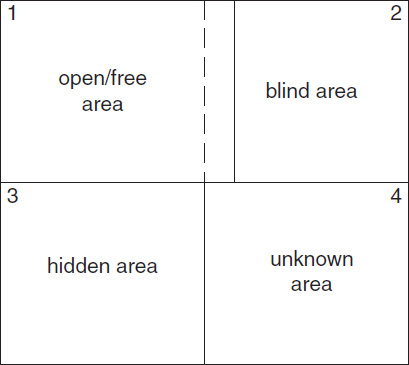
The Johari Window in figure 11-3 is an example of a member of a new team or a person who is new to an existing team.
The open/free region and blind area are small because others know little about the new person. The hidden area is relatively large. In this example, the unknown area is the largest, likely because the person is young or lacking in self-knowledge or belief. Both time and leader feedback that is acted upon by the team member can minimize the unknown.
The Johari Window in figure 11-4 is an example of an established member of a team.
Figure 11-3: Johari Window Model: Example for New Team Member or Member Within a New Team
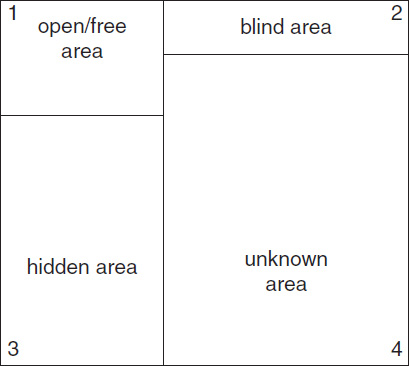
Figure 11-4: Johari Window Example: Established Team Member
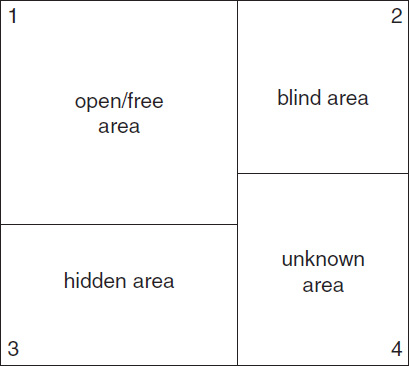
The open/free region is large because others know a lot about this person that he or she also knows. Through disclosure and feedback, often the result of on-the-job work-related discussions, the open area has expanded, and the sizes of the hidden, blind, and unknown areas have been reduced.
In summary, the Johari Window is a simple and powerful model that, when understood, empowers people to think about themselves differently, so they can make appropriate behavioral changes. It is also a critical leadership tool that helps managers and owners understand the power of feedback and coaching, leading them to what Robert Fritz and Bruce Bodaken refer to as the managerial moment of truth.
Giving Feedback
With the Johari Window as a backdrop, please consider the following:
Recall a positive experience in which you were given feedback.
— Why was the experience positive?
— What did the giver do or say that made the experience positive?
Now, recall a negative experience in which you were given feedback.
— Why was the experience negative?
— What did the giver do or say that made the experience negative?
Your positive experiences were likely the result of a leader whose intent was in your best interest and who delivered the message in an empathic and a constructive way. Effective feedback can be described as follows:
Includes information about the past (specific, descriptive examples of behavior and the impact on the firm or results)
Is delivered in the present (as soon as possible after the situation or incident)
Influences (changes) the future
Is delivered in a nonthreatening manner
Keeps the relationship open and intact
To prepare for delivering feedback, take a moment for self-awareness and consider the following:
Reflect on your own thoughts and feelings about the situation, and challenge your assumptions or reactions.
Prepare and document your feedback in advance.
Visualize the feedback conversation beforehand, and anticipate the other person’s comments or reactions based on personal style.
Practice delivering the feedback.
In cases of egregious behaviors (for example, unethical or illegal behavior; acts that put themselves, others, or the firm at risk; and so on), you may want to consult with an employment attorney before delivering feedback, taking corrective action, or terminating an employee. In these cases, we advise you to include another member of the firm (for example, another owner, the HR professional, and so on) in all meetings.
Before delivering feedback, ask for permission to do so. While delivering feedback
describe the behavior: what you observed.
identify the situation: when you observed it and how it happened.
describe the impact or consequence: “So what?”
encourage the other person to share his or her perspective on the behavior or event.
paraphrase the other person’s viewpoints to confirm understanding.
acknowledge and accept the feelings, intentions, and values the other person is communicating.
recognize that constructive feedback may raise emotions.
mutually explore alternative behaviors or solutions: “Now what?”
discuss and seek commitment: “When and where will this happen?”
If we apply these questions and characteristics, the feedback exchange may look like this:
“Chris, may I share some feedback with you?” (Assume a positive response from Chris.)
After I reviewed the working papers you completed for (name of client) and the comments that (name of client) provided back to you on March 11, I note you did not address all of them before returning the working papers on March 13. When you don’t address each comment, it causes another round of review and correction, causing the work to be late to the client. When that happens, our credibility and, possibly, the relationship is compromised. Please tell me your thoughts.
Then, the leader allows the team member to share his or her perspective on things while listening empathically. Together, they can create an action plan for effectively dealing with this incident and preventing similar occurrences in the future. Assuming they agree on the next steps, as well as when and where this will happen, they reconfirm their commitment to each other.
After delivering feedback, follow up. “Has it been done, and what was the impact?”
To create a culture in which people can get better, find someone doing something well each day, and tell them so. At the same time, don’t be afraid to confront reality when someone isn’t doing something well. Feedback is one of the greatest ways to give and earn respect—one of the greatest gifts you can give to employees.
Performance Evaluations
We mention that clarify expectations is a behavior of a high-trust leader. Stephen M.R. Covey shares that practice accountability is another. Keep in mind that you can practice accountability better when you’ve clarified expectations first. Covey explains that leaders who generate trust hold themselves accountable first and then hold others accountable second. So, when team members fall short of expectations, great leaders look to themselves first and determine where they have fallen short either in clarifying the expectations or ensuring team members had the necessary resources to accomplish them.
We’ve discussed the gift of feedback and that it should occur regularly. When it comes to formal performance evaluations, generally conducted annually, everything we’ve discussed certainly applies. In addition, in exhibit 11-1 which is included at the end of this chapter, we include an example of an employee performance evaluation based on a clearly defined set of expectations (see chapter 12 “Owners Need to Be Evaluated, Too” and chapter 13, “Even Managing Owners Need Feedback,” for examples of owner and managing owner evaluations).
When conducting the performance evaluation, please keep in mind that employees should not be surprised by the feedback. In addition to the guidelines we outlined earlier in the chapter, we suggest you follow the guidelines below when it comes to delivering the annual (or semiannual) evaluation:
Agree together at the beginning of the evaluation period those competencies the employee should improve upon throughout the year. You may even wish to create an individual development plan that specifies those competencies and the activities in which the employee will engage to develop them.
Approximately two weeks prior to the evaluation session, provide the evaluation form to the employee, and ask the employee to complete it based on his or her paradigms about his or her level of competency or performance.
Identify a time and place that will be private and conducive to no interruptions.
Engage in two-way conversation using empathic listening skills.
Agree upon needed actions for improvement, and document them in writing with a deadline for completion.
Final Thoughts
It’s up to you. You can create a firm in which people stay and thrive, or you can create one in which the revolving door never stops. Every time you talk with team members, you’re creating culture. Make every conversation safe, and help your team members define their contribution and understand the measures of performance. Easy? No. Simple? Yes.
Exhibit 11-1: Performance Evaluation
Employee Name: ___________________________ Review Date: ___________________________
Evaluator Name: ___________________________ Evaluator Title: ___________________________
Rating
Rate the individual’s effectiveness in each category listed subsequently by placing a “✓” in the appropriate box. Total the number of “✓” in each column.
Far Below Expectations—Individual is clearly not meeting expectations at his or her experience level. Comments must be provided if this rating is selected, so the problem(s) can be addressed.
Below Expectations—Individual is having difficulty meeting expectations for his or her experience level.
Meets Expectations—This rating is the initial point of reference for evaluating the individual. It indicates the individual is meeting expectations at his or her level of experience. This rating means the person is considered to have the potential to progress to the next promotion level.
Above Expectations—Individual has surpassed expectations for his or her experience level.
Far Above Expectations—Individual has clearly and consistently surpassed expectations for his or her experience level, as well as others in the same experience level. Comments must be provided if this rating is selected.
Not Applicable—Evaluator is unable to rate individual on this item, or item does not apply to the individual being evaluated.

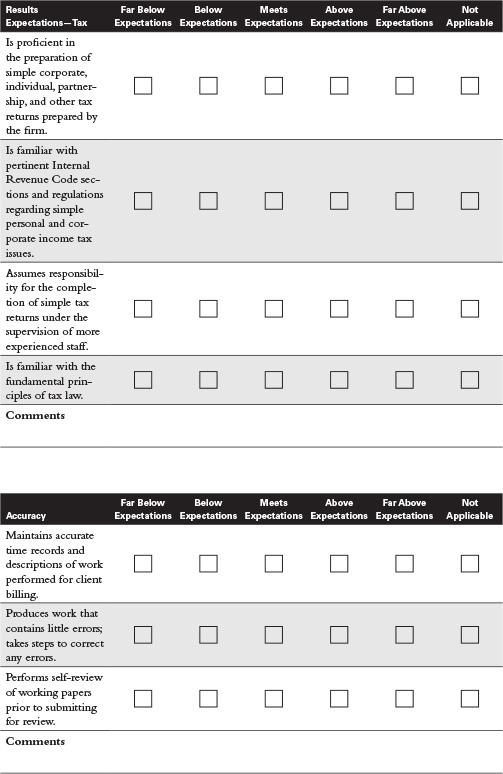
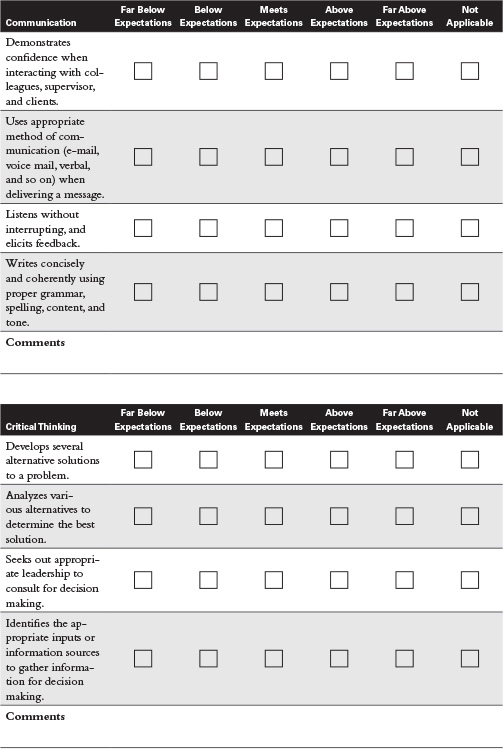
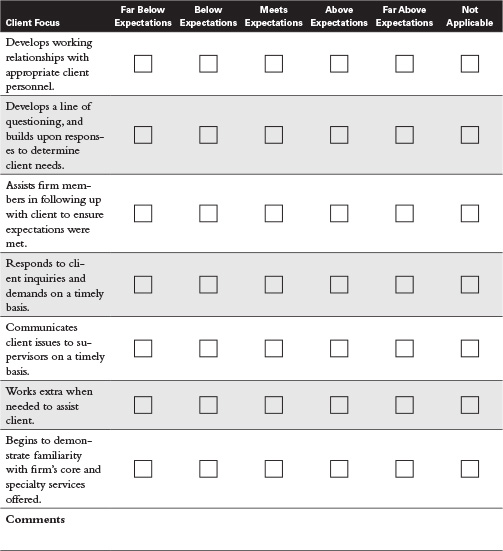
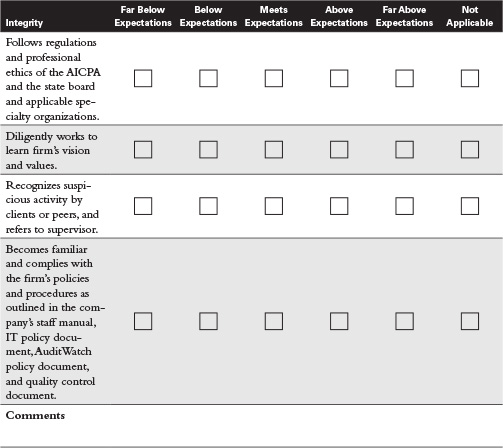
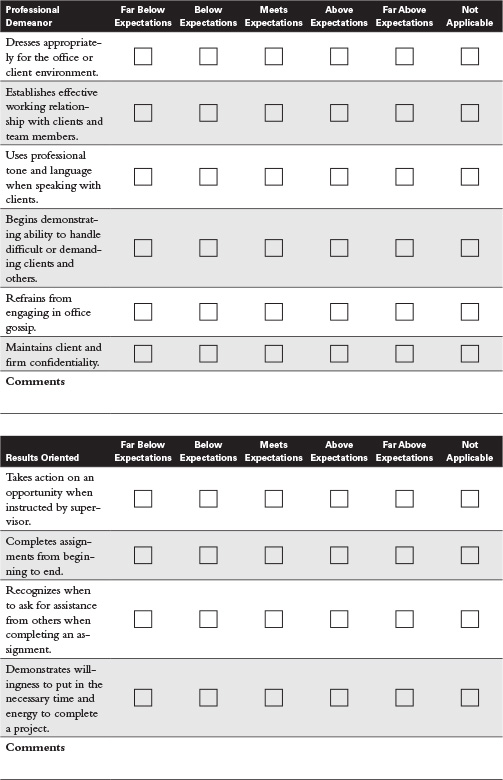

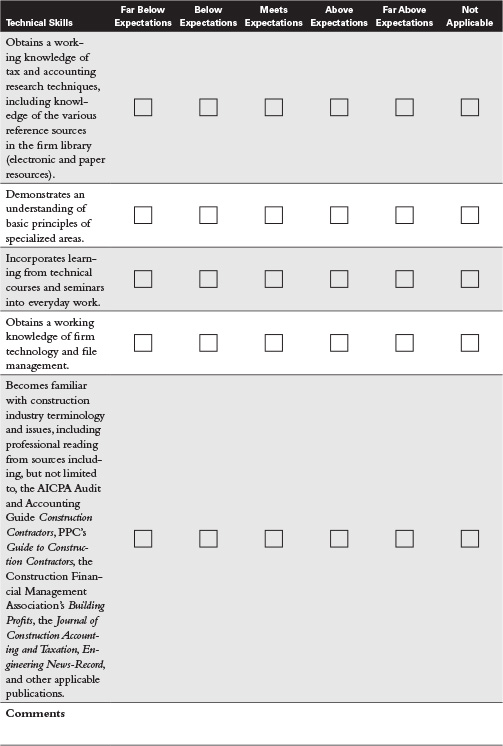
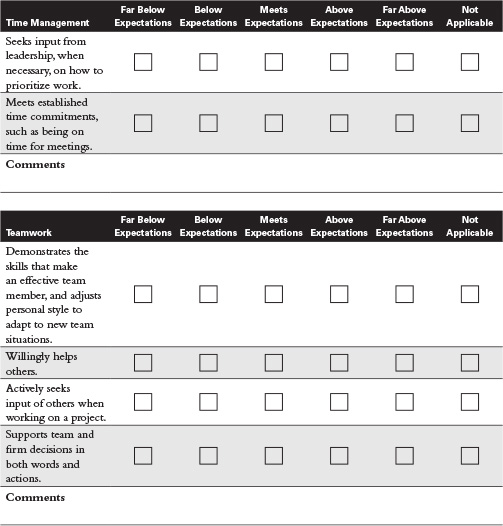
MAJOR ACCOMPLISHMENTS THIS YEAR:
___________________________________________________________________________
___________________________________________________________________________
___________________________________________________________________________
___________________________________________________________________________
EMPLOYEE COMMENTS:
___________________________________________________________________________
___________________________________________________________________________
___________________________________________________________________________
___________________________________________________________________________
___________________________________________________________________________
PROFESSIONAL DEVELOPMENT GOALS:
___________________________________________________________________________
___________________________________________________________________________
___________________________________________________________________________
Employee Signature: ____________________________ Date: _____________
Complete This Section Only For Annual Performance Reviews OVERALL RATING
Based on the results of this review, please assign an overall rating by checking only one of the following boxes.
| Far Below Expectations | Below Expectations | Meets Expectations | Above Expectations | Far Above Expectations |
PROMOTION—Do you believe this individual is ready for the next level?
| Yes | No | Not applicable at this time |
SIGNATURES (The signatures of both the individual being evaluated and the evaluator are required.)
I, the individual being evaluated herein, have discussed this review with the evaluator and ![]() agree/
agree/ ![]() disagree with his or her ratings and recommendations. (Comments may be attached.)
disagree with his or her ratings and recommendations. (Comments may be attached.)
| Signature: _____________________________ | Date: ______________ |
| Evaluator Signature: _____________________ | Date: ______________ |
| Principal Signature: ______________________ | Date: ______________ |
| Received by Administrative Services: _________ | Date: ______________ |
